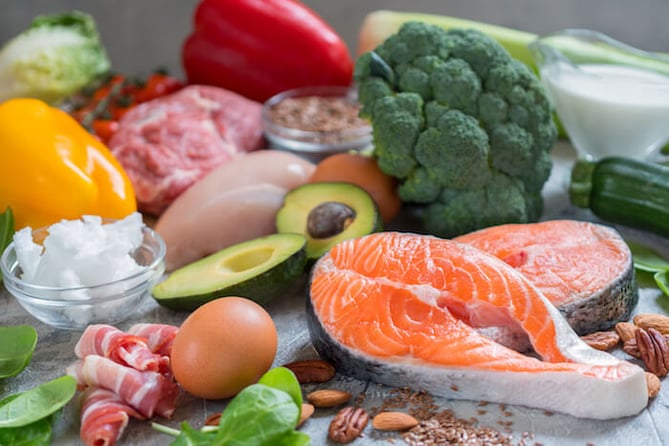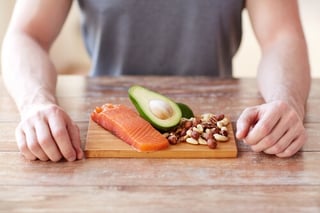Diet trends seem to come and go as reliably as tourists at the beach. Before you try a food fad, it’s worth asking yourself some questions. You should consider if the diet will actually help you reach your specific goal, if the diet is healthy, and if it is a practical option.

We rounded up these helpful questions and answers about one of the latest trends, the Ketogenic diet:
What is the Ketogenic (Keto) Diet?
Although the concept of the Ketogenic diet has been around since the 1970s, it’s picked up traction in more recent years. The concept behind the diet is simple: eat fewer carbs. Without as many carbs to use for energy, your body will produce ketones in the liver to use as energy instead. Ketones are made by breaking down fat.
So, unlike low-calorie diets, the Ketogenic diet reduces carb intake to change your metabolism temporarily. That gets your body to burn fat. This process is called ketosis.
What are the Rules of the Diet?
 Since ketosis depends on your body using fat for food, the ketogenic diet involves 70% of your diet being fats. Between the healthy fats you consume and the stored fats your body breaks down, the diet can be excellent for weight loss and still be tasty. On this diet, your other macronutrient intake should be 25% protein and 5% carbs.
Since ketosis depends on your body using fat for food, the ketogenic diet involves 70% of your diet being fats. Between the healthy fats you consume and the stored fats your body breaks down, the diet can be excellent for weight loss and still be tasty. On this diet, your other macronutrient intake should be 25% protein and 5% carbs.
Foods to avoid:
- Grains
- Sugar
- Fruit
- Veggies that grow under the ground
Foods to eat:
- Meats
- Leafy greens
- Veggies that grow above ground
- Fatty dairy
- Nuts
- Seeds
- Avocado
- Berries
- Fatty oil and dressings
Does this Diet Actually Work?
 Unlike many diet trends, the Ketogenic diet indisputably works if it is followed closely. Experts at Harvard Health acknowledge that the science of ketosis is real and effective for fat loss. In fact, ketogenic dieting offers several possible benefits, like:
Unlike many diet trends, the Ketogenic diet indisputably works if it is followed closely. Experts at Harvard Health acknowledge that the science of ketosis is real and effective for fat loss. In fact, ketogenic dieting offers several possible benefits, like:
- Weight loss
- Diabetes prevention and maintenance
- Reduced seizures in kids
- Improved brain function
People who are committed to a healthy workout often see huge weight loss results on this diet. Some bodybuilders even use it to trim any lasting fat.
Is This Diet Safe and Healthy?
The reason ketosis happens is that the body is starved of the carbs you need for energy. When you’re on the ketogenic diet, your body is operating on its metabolic “back up plan.” Since it is a natural process, that won’t hurt your body in the short-term.
However, despite being safe for short-term use, the ketogenic diet can be unhealthy in the long term. There is a reason, after all, that “fat” is not the main macronutrient in most diets. A steady diet of fat can be bad for the heart, cholesterol, and much more.
Is the Ketogenic Diet Practical?
 Most people agree that sticking to the ketogenic diet is hard work. After all, 5% of your carbs for the day can be found in just one big banana! Since most of the foods you eat on the diet are fresh, getting to the store often and having time to prepare ingredients can also be a problem.
Most people agree that sticking to the ketogenic diet is hard work. After all, 5% of your carbs for the day can be found in just one big banana! Since most of the foods you eat on the diet are fresh, getting to the store often and having time to prepare ingredients can also be a problem.
To make the diet work for you, it’s best to commit to just 2 weeks with a solid meal plan to start. You’ll also need to be working out to make the diet count.
What are the Best Ketogenic Meals?
 Despite its challenges, trying the ketogenic diet for the short term can be smart if you have fat you want to burn. Use these meal examples to get started on your keto plan:
Despite its challenges, trying the ketogenic diet for the short term can be smart if you have fat you want to burn. Use these meal examples to get started on your keto plan:
Breakfast:
- High-fat yogurt or cottage cheese
- Berries or avocado
- Eggs with low carb veggies
Lunch:
- Nuts or seeds
- Salads with fatty dressings
- Healthy keto smoothies
Dinner:
- Sesame chicken and veggies
- Meaty salads
- Meat and veggie casseroles
*Before starting any food plan or diet plan, it is recommended that you discuss with your doctor and/or nutritionist to make sure the nutrients are appropriate for your body, age and needs.
Gold’s Gym SoCal is an association of separate clubs—click here for info.
To make sure your body is working hard to burn all the fat the Keto diet produces for energy, be sure to have an intense workout plan. Try this FREE 30 Min HIIT Guide to get started.


-1.jpg)

